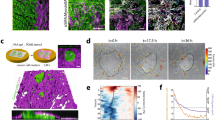Abstract
Cells within a tumor interact by generating, transmitting, and sensing mechanical forces. Among all the cells of the tumor microenvironment, cancer-associated fibroblasts (CAFs) are a paradigmatic example of mechanical communication. In different steps of tumor progression, CAFs pull and push on cancer cells, regulating cancer cell migration, invasion, compartmentalization, and signaling. There is thus an increasing need to experimentally address mechanical interactions within a tumor. A common technique to measure these interactions is laser ablation. Cutting a tissue region with a high-power laser triggers a sudden tissue displacement whose direction and magnitude reveal the local mechanical stresses. In this chapter, we provide a detailed protocol to perform laser ablations in vitro and ex vivo. First, we describe how to prepare cocultures of primary CAFs and cancer cells and tumor explants. Then, we explain how to perform laser ablations in these two systems and how to analyze the induced tissue displacements using particle image velocimetry (PIV). Overall, we provide a workflow to perform, analyze, and interpret laser ablations to explore tumor mechanical interactions.
Access this chapter
Tax calculation will be finalised at checkout
Purchases are for personal use only
Similar content being viewed by others
References
Attieh Y, Clark AG, Grass C et al (2017) Cancer-associated fibroblasts lead tumor invasion through integrin-beta3-dependent fibronectin assembly. J Cell Biol 216:1–12
Glentis A, Oertle P, Mariani P et al (2017) Cancer-associated fibroblasts induce metalloprotease-independent cancer cell invasion of the basement membrane. Nat Commun 8:924
Erdogan B, Ao M, White LM et al (2017) Cancer-associated fibroblasts promote directional cancer cell migration by aligning fibronectin. J Cell Biol 216:3799–3816
Labernadie A, Kato T, Brugués A et al (2017) A mechanically active heterotypic E-cadherin / N-cadherin adhesion enables fibroblasts to drive cancer cell invasion. Nat Cell Biol 19:224–237
Barbazan J, Pérez-González C, Gómez-González M et al (2023) Cancer-associated fibroblasts actively compress cancer cells and modulate mechanotransduction. Nat Commun 14:6966
Krndija D, Marjou FE, Guirao B et al (2019) Active cell migration is critical for steady-state epithelial turnover in the gut. Science 80- ) 365:705–710
Shivakumar PC, Lenne PF (2016) Laser ablation to probe the epithelial mechanics in drosophila. Methods Mol Biol 1478:241–251
Zulueta-Coarasa T, Fernandez-Gonzalez R (2015) Laser ablation to investigate cell and tissue mechanics in vivo. In: Simmons CA, Kim D-H, Sun Y (eds) Integrative Mechanobiology: micro- and nano- techniques in cell mechanobiology. Cambridge University Press, Cambridge, pp 128–147
Pérez-González C, Ceada G, Greco F et al (2021) Mechanical compartmentalization of the intestinal organoid enables crypt folding and collective cell migration. Nat Cell Biol 23:745–757
Campàs O, Mammoto T, Hasso S et al (2014) Quantifying cell-generated mechanical forces within living embryonic tissues. Nat Methods 11:183–189
Träber N, Uhlmann K, Girardo S et al (2019) Polyacrylamide bead sensors for in vivo quantification of cell-scale stress in Zebrafish development. Sci Rep 9:17031
Liang X, Michael M, Gomez G (2016) Measurement of mechanical tension at cell-cell junctions using two-photon laser ablation. Bio-Protocol 6:e2068
Bonnet I, Marcq P, Bosveld F et al (2012) Mechanical state, material properties and continuous description of an epithelial tissue. J R Soc Interface 9:2614–2623
Serra-Picamal X, Conte V, Sunyer R et al (2015) Mapping forces and kinematics during collective cell migration. Methods Cell Biol 125:309–330
Staneva R, Barbazan J, Simon A et al (2018) Cell migration in tissues: explant culture and live imaging. In: Methods in molecular biology, pp 163–173
Tseng Q, Duchemin-Pelletier E, Deshiere A et al (2012) Spatial organization of the extracellular matrix regulates cell-cell junction positioning. Proc Natl Acad Sci U S A 109(5):1506–1511
Trepat X, Wasserman MR, Angelini TE et al (2009) Physical forces during collective cell migration. Nat Phys 5:426–430
Calvo F, Hooper S, Sahai E (2014) Isolation and immortalization of fibroblasts from different tumoral stages. Bio-protocol 4:e1097
Acknowledgments
We thank the Cell and Tissue Imaging Facility (PICT-IBiSA) at Institut Curie, and specially O. Renaud for technical assistance, as well as Matic-Vignjevic and Trepat labs for sharing continuous discussions, expertise, and scripts. This work was supported by the Juan de la Cierva grant program to Jorge Barbazan (IJC2018-036875-I, Ministerio de Ciencia e Innovación), and Fondation ARC pour la Recherce sur le Cancer to Carlos Perez Gonzalez.
Author information
Authors and Affiliations
Corresponding authors
Editor information
Editors and Affiliations
Rights and permissions
Copyright information
© 2024 The Author(s), under exclusive license to Springer Science+Business Media, LLC, part of Springer Nature
About this protocol
Cite this protocol
Perez-Gonzalez, C., Barbazán, J. (2024). Addressing the Mechanical Interaction Between Cancer-Associated Fibroblasts and Cancer Cells by Laser Ablation. In: Sumbalova Koledova, Z. (eds) 3D Cell Culture. Methods in Molecular Biology, vol 2764. Humana, New York, NY. https://doi.org/10.1007/978-1-0716-3674-9_13
Download citation
DOI: https://doi.org/10.1007/978-1-0716-3674-9_13
Published:
Publisher Name: Humana, New York, NY
Print ISBN: 978-1-0716-3673-2
Online ISBN: 978-1-0716-3674-9
eBook Packages: Springer Protocols




